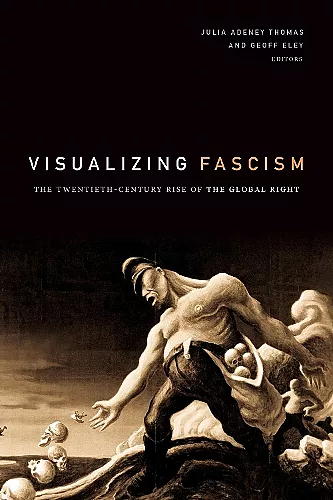Visualizing Fascism
The Twentieth-Century Rise of the Global Right
Julia Adeney Thomas editor Geoff Eley editor
Format:Hardback
Publisher:Duke University Press
Published:13th Mar '20
Currently unavailable, and unfortunately no date known when it will be back
This hardback is available in another edition too:
- Paperback£22.99(9781478003762)

Visualizing Fascism argues that fascism was not merely a domestic menace in a few European nations, but arose as a genuinely global phenomenon in the early twentieth century. Contributors use visual materials to explore fascism's populist appeal in settings around the world, including China, Japan, South Africa, Slovakia, and Spain. This visual strategy allows readers to see the transnational rise of the right as it fed off the agitated energies of modernity and mobilized shared political and aesthetic tropes. This volume also considers the postwar aftermath as antifascist art forms were depoliticized and repurposed in the West. More commonly, analyses of fascism focus on Italy and Germany alone and on institutions like fascist parties, but that approach truncates our understanding of the way fascism was indebted to colonialism and internationalism with all their attendant grievances and aspirations. Using photography, graphic arts, architecture, monuments, and film—rather than written documents alone—produces a portable concept of fascism, useful for grappling with the upsurge of the global right a century ago—and today.
Contributors. Nadya Bair, Paul D. Barclay, Ruth Ben-Ghiat, Maggie Clinton, Geoff Eley, Lutz Koepnick, Ethan Mark, Bertrand Metton, Lorena Rizzo, Julia Adeney Thomas, Claire Zimmerman
“In a volume of instructive and newly timely essays, we learn about the key role played by the circulation of people and the visual culture they made in constructing fascism's global imaginary of interconnectedness. From the 1920s to the 1950s, fascist visuality in Asia and Europe brought the intimacies of everyday life and the realm of mass spectacle together in a variety of forms. Moving beyond the usual subjects of futurism and Leni Riefenstahl, the volume expands the visual repertoire of the period's politicized visual field as it reintroduces readers to its contested grounds.” -- Vanessa R. Schwartz, Director, Visual Studies Research Institute, University of Southern California
“Unlike so many works that relegate the phenomenon of fascism to a few moments in the past and to an isolated number of usual suspects, this wide-ranging volume focuses on the visual but goes way beyond it to demonstrate that fascism has come in varied but contiguous forms throughout the world—and perhaps as important, threatens to do so again in our time. An absolutely stunning and pathbreaking intervention by leading scholars of fascism and modernity.” -- Takashi Fujitani, author of * Race for Empire: Koreans as Japanese and Japanese as Americans during WWII *
"The book highlights the saliency of bridging the written and the visual and urges historians not to restrain from enriching their 'historians's craft' by listening to, reading and looking at the silence of images." -- Elena Maria Rita Rizzi * European Review of History *
"The volume has much to offer due to the geographical scope of its case studies.… Visualizing Fascism is a welcome addition to the literature, calling for an understanding of fascism as a transnational phenomenon typified by the fluid circulation of fascist ideology and imagery." -- Mark Antliff * Journal of Visual Culture *
ISBN: 9781478003120
Dimensions: unknown
Weight: 590g
336 pages